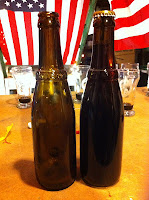 chance to revisit Founders, which is always a pleasure. Our previous encounters with Founders include Nemesis 2010, Newaygo County Cherry, Devil Dancer, Pale Ale, KBS (as a bonus beer), Centennial IPA, Black Biscuit, Harvest Ale, and Breakfast Stout.
chance to revisit Founders, which is always a pleasure. Our previous encounters with Founders include Nemesis 2010, Newaygo County Cherry, Devil Dancer, Pale Ale, KBS (as a bonus beer), Centennial IPA, Black Biscuit, Harvest Ale, and Breakfast Stout.
Founders Imperial Stout pours an inky—and I mean inky—dark chocolate brown with a very minimal cappuccino head. The head looks like the thin skiff covering you’d get on a cappuccino, and the beer itself is thick as well—you can see the small, tiny bubbles struggling to escape the viscous liquid, leaving only the barest sheen of an arabesque covering. The nose is chocolate, coffee, and roast (in that order), with the chocolate taking up much of the extra space around the other two. As it warms, a softer caramel sweetness starts to emerge from the chocolate, as does more of the soft roast character along with some cocoa. There may be some hints of tobacco and leather lurking as well. Flavors open with chocolate,  coffee, and roast, lead into caramel and a slight roasted sour tang in the middle, and finish with a chalky mineral roast that lingers pleasantly on the back of the throat, slowly getting more alkaline as it fades before ending with cocoa. The mouthfeel is rich, chewy, and rounded, although the roast presence thins and cleanses the palate in the finish, smoothing the beer more than would be anticipated in the initial sip. Surprisingly little alcohol warmth or flavor anywhere to be found in this beer, although a touch emerges as the beer warms. The residual roast chocolate on the back of the throat is enjoyable; the roast might be a bit excessive in relation to the other elements of the beer—it is a bit one-dimensional in that regard—but again, it is not over the top. All in all, a smooth-sipping
coffee, and roast, lead into caramel and a slight roasted sour tang in the middle, and finish with a chalky mineral roast that lingers pleasantly on the back of the throat, slowly getting more alkaline as it fades before ending with cocoa. The mouthfeel is rich, chewy, and rounded, although the roast presence thins and cleanses the palate in the finish, smoothing the beer more than would be anticipated in the initial sip. Surprisingly little alcohol warmth or flavor anywhere to be found in this beer, although a touch emerges as the beer warms. The residual roast chocolate on the back of the throat is enjoyable; the roast might be a bit excessive in relation to the other elements of the beer—it is a bit one-dimensional in that regard—but again, it is not over the top. All in all, a smooth-sipping  slow-drinking big beer, perfect for cold late fall/early winter evening. While this is not the best RIS we’ve ever had, it is certainly solid across the board.
slow-drinking big beer, perfect for cold late fall/early winter evening. While this is not the best RIS we’ve ever had, it is certainly solid across the board.
 coffee, and roast, lead into caramel and a slight roasted sour tang in the middle, and finish with a chalky mineral roast that lingers pleasantly on the back of the throat, slowly getting more alkaline as it fades before ending with cocoa. The mouthfeel is rich, chewy, and rounded, although the roast presence thins and cleanses the palate in the finish, smoothing the beer more than would be anticipated in the initial sip. Surprisingly little alcohol warmth or flavor anywhere to be found in this beer, although a touch emerges as the beer warms. The residual roast chocolate on the back of the throat is enjoyable; the roast might be a bit excessive in relation to the other elements of the beer—it is a bit one-dimensional in that regard—but again, it is not over the top. All in all, a smooth-sipping
coffee, and roast, lead into caramel and a slight roasted sour tang in the middle, and finish with a chalky mineral roast that lingers pleasantly on the back of the throat, slowly getting more alkaline as it fades before ending with cocoa. The mouthfeel is rich, chewy, and rounded, although the roast presence thins and cleanses the palate in the finish, smoothing the beer more than would be anticipated in the initial sip. Surprisingly little alcohol warmth or flavor anywhere to be found in this beer, although a touch emerges as the beer warms. The residual roast chocolate on the back of the throat is enjoyable; the roast might be a bit excessive in relation to the other elements of the beer—it is a bit one-dimensional in that regard—but again, it is not over the top. All in all, a smooth-sipping  slow-drinking big beer, perfect for cold late fall/early winter evening. While this is not the best RIS we’ve ever had, it is certainly solid across the board.
slow-drinking big beer, perfect for cold late fall/early winter evening. While this is not the best RIS we’ve ever had, it is certainly solid across the board. From the Founders website: “Brewed with ten varieties of malted barley, this stout is smooth as silk, yet complex and rich in body. Serve this guy at cellar temperature. Put another log on the fire, sit back, and enjoy the friendship of this ultimate winter warmer.”
ABV: 10.5%
IBU: 90
(11/25/2012)




































